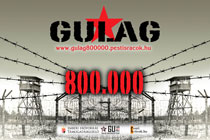800 000 Hungarians
Can anyone suggest a good movie about the Gulag? Nobody can? It’s not a surprise. The story of the Soviet death camps were not discussed for long, or simply they were considered “not important”. The Soviet Union were carefully hiding every single document until the fall of the system. The survivors were not allowed to visit the former venues and the witnesses were ordered not to tell anyone about what they had seen. For a very long time the members of the the left-wing elite were also conspiratorially silent in order not to hurt the socialist concept, and instead of facing the truth they ostracised people like Albert Camus or Aleksandr Solzhenitsyn. The works of Nobel Prize-winning Russian writer had to be smuggled into Hungary from the West, the “Gulag” and the “One day of Ivan Denisovich” was read only by the insiders. However, their news spread quite fast. More and more people realised what kind of terrible things happened to the Hungarians taken away during the Second World War.
Even today we don’t know how many millions of victims the Gulag killed exactly, and it would be a mistake to blame only Stalin for the deaths of the innocents. The Soviet lagers were first built by Lenin right after he rose to power. The aim was clear: they separated and punished the imaginary or real enemies of the Bolshevik, Communist dictatorship, so that while doing so they also could use the prisoners as workers. Just like the Nazis, the Communists also made their prisoners work themselves to death, and although the “final solution” on the East never happened, the red dictatorship didn’t even need it. The Soviet regime was slowly, patiently working and had a lot more time to destroy those who opposed the system.
If we think about the Gulag, we talk about a vast and unavoidable network. During the darkest days of the dictatorship there were more than 2000 camps in the Soviet Union, some of them were built for only women and children. Two thousand “meat grinders’ as the prisoners called them.
Here in Hungary for many years it was forbidden to speak about the truth, and the exploration of the full story didn’t happen even after the regime change. Many were interested in keeping silent to diminish the importance of the events. Even renowned historians were convinced to play along. Although a lot have happened since then only a selected few chosen by Moscow can get near the Soviet papers. Due to this we still do not know exactly how many people were taken away from Hungary by force. We believe approximately 800 000, and from among them at least 300 000 never came back home. Let’s repeat this horrible number: 300 000. They were eaten up by the empire of the Gulag. We remember them too.
Hungarians might be more touched by the reality of the still haunting world of the Gulag-death camps than other nations in Central Europe. Our “prorated” loss of people in World War II was the fourth largest in the world: 6.2 per cent of our population perished. Our country follows Poland, Germany and the Soviet Union, and if we add the losses of Trianon we can see that the statistics are dramatic.
The invading Soviet army – just like the Nazis a couple of months before – arrived with ready lists.
They searched for and seized everybody whom they considered dangerous to the Communist takeover. Among them former prime ministers, ministers, MPs, ambassadors, military officers, priests, and teachers. They also took the working youth without hesitating for a second. Most of them were younger than 20.
Thos who they took were first dragged to collecting camps in Hungary then to transit camps in Máramarossziget Foksány, Brassó, and Temesvár. From there only after weeks of shipping in stock cars did they arrive in one of the camps of the 200 locations in the Soviet lager-world. More than 700 000 Hungarians were killed by the Gulag-empire encompassing the entire territory of the USSR.

